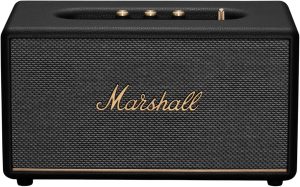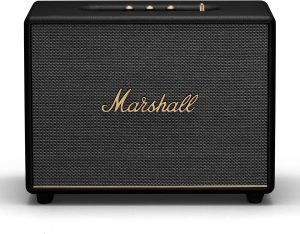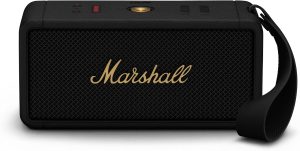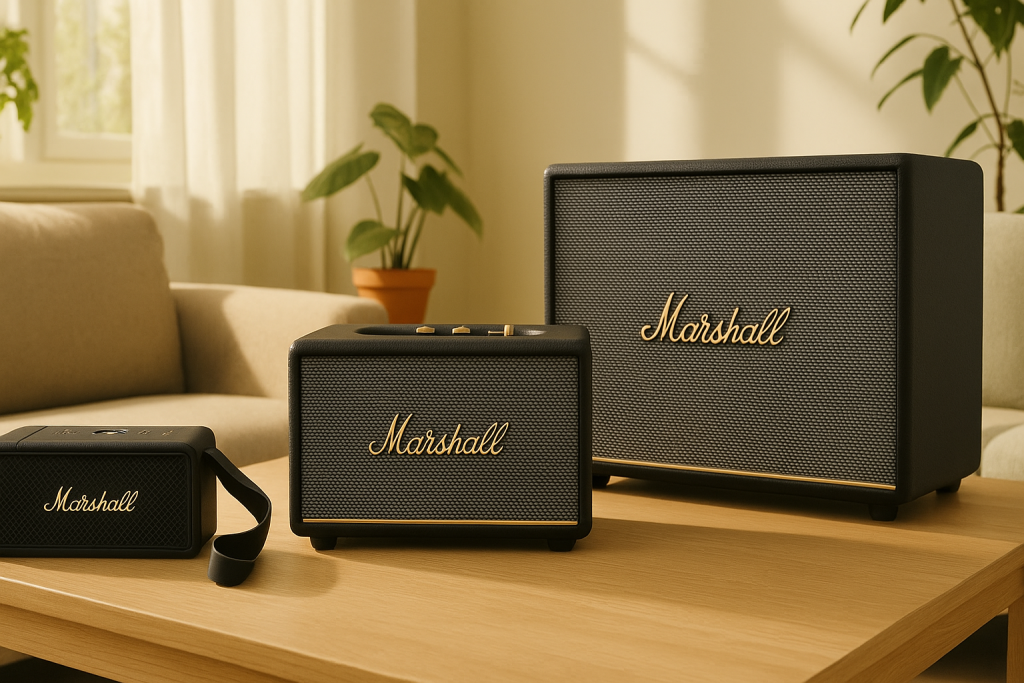Marshall Stanmore III vs Woburn III vs Middleton: Which One is Best for Home Audio?
Share this article
Get Your Backstage Pass
If you’ve been eyeing a Marshall Bluetooth speaker for your home setup, you’ve probably noticed there are a few heavy hitters in the lineup. Three of the most talked-about are the Stanmore III, Woburn III, and Middleton.
All three carry Marshall’s legendary amp-inspired look, and all three are capable of filling a room with music—without the need for a bulky, multi-speaker setup. The question is: which one is right for you?
Let’s break it down.
Quick Comparison
| Photo | Model | Price (USD) | Power / Drivers | Room-Filling Ability | What Stands Out | Trade-Offs |
|---|---|---|---|---|---|---|
 | Stanmore III | ~$399 | 50W woofer + 2×15W tweeters | Easily fills medium to large rooms (~97 dB SPL) | Wide soundstage with angled tweeters, Placement Correction via app, classic styling | Bass not as deep as a subwoofer; no HDMI |
 | Woburn III | ~$599 | 3-way system, 150W total | Strongest of the three; “home-shaking” for big rooms | HDMI input for TV, Dynamic Loudness keeps balance at any volume, deeper bass | Large and heavy; pricier; AC only |
 | Middleton | ~$250 | 60W, 360° sound design | Best for small to medium rooms; can sound bigger than its size suggests | Portable, IP67 waterproof, Stack Mode links multiple units | Won’t match the depth or headroom of Stanmore/Woburn |
How They Perform in Real Rooms
Marshall Stanmore III – The Balanced Choice
 The Stanmore III is Marshall’s “just right” speaker for most households. It sits between compact models like the Acton and the massive Woburn, striking a balance between size, power, and price.
The Stanmore III is Marshall’s “just right” speaker for most households. It sits between compact models like the Acton and the massive Woburn, striking a balance between size, power, and price.
Sound Signature: Warm mids, crisp treble, and enough low-end punch to make pop, rock, hip-hop, and even orchestral music feel satisfying. While it doesn’t plunge into the sub-30Hz range like a home theater subwoofer, it delivers bass that feels tight and musical rather than boomy.
Volume & Headroom: With ~97 dB SPL output, the Stanmore III has no problem filling a living room, loft, or open-plan kitchen/living space. You can push it to party levels without distortion creeping in.
Soundstage & Dispersion: The outward-angled tweeters and waveguides widen the stereo field, meaning you don’t have to sit dead-center to enjoy balanced sound. This makes it excellent for casual listening when moving around a room.
Features That Matter: The Marshall app gives you EQ control and a “Placement Compensation” feature, which adjusts output depending on whether it’s close to a wall or in an open space. That kind of DSP tweak makes a noticeable difference in home environments.
Use Case: If you want a single-box system that handles daily listening, dinner parties, and even moderate home theater use, this is the sweet spot. For bass lovers, pairing it with a small sub is the only real upgrade path needed.
Bottom line: For most people, the Stanmore III is the ideal balance of power, size, and cost. It can convincingly replace a 2.0 bookshelf system for music while being far less clutter.
Marshall Woburn III – The Heavyweight
 The Woburn III is the flagship of the home line — and it sounds like it. This is the model for those who want the biggest, boldest sound possible from a single speaker cabinet.
The Woburn III is the flagship of the home line — and it sounds like it. This is the model for those who want the biggest, boldest sound possible from a single speaker cabinet.
Sound Signature: With a dedicated 3-way system (woofer, mids, tweeters), the Woburn III provides a more layered and hi-fi-like experience. Vocals are rich, bass is deep and authoritative, and treble sparkles without getting shrill. It maintains clarity even at low volumes, thanks to Dynamic Loudness, which balances frequency response as you turn the knob up or down.
Volume & Headroom: At ~110 dB SPL max, this thing is loud. It’s designed to fill very large rooms or open floor plans, making it ideal for house parties or even acting as a soundbar replacement in a living room.
Bass & Impact: This is where the Woburn sets itself apart. You’ll feel the kick drum or EDM drop in your chest. It digs deeper than the Stanmore and Middleton, giving you that physical sense of bass without needing a separate subwoofer.
Connectivity: The inclusion of HDMI ARC is a game-changer. You can connect it directly to your TV, replacing both a stereo system and a soundbar. For apartment dwellers or those who don’t want multiple speakers, this makes the Woburn a truly all-in-one home audio hub.
Tradeoffs: It’s heavy and big (around 18 inches wide), so placement requires some thought. It’s also the most expensive of the three, but considering it can replace a hi-fi or home theater starter setup, it’s still good value.
Bottom line: If you want cinematic sound and room-shaking volume from one box, the Woburn III is unbeatable. It’s the closest thing to a full hi-fi system without actually building one.
Marshall Middleton – Compact but Mighty
 The Middleton is the smallest of the trio, but don’t write it off as “just a portable.” In many ways, it’s the most versatile, delivering impressive fullness for its size and flexibility for use both indoors and outdoors.
The Middleton is the smallest of the trio, but don’t write it off as “just a portable.” In many ways, it’s the most versatile, delivering impressive fullness for its size and flexibility for use both indoors and outdoors.
Sound Signature: Marshall’s True Stereophonic 360° design spreads sound in all directions. This is key for smaller rooms or gatherings, where you don’t want sound focused in one spot. The tonality is balanced, with surprisingly strong bass for its footprint, though it can’t match the weight of Stanmore or Woburn.
Volume & Room Coverage: On its own, the Middleton is well-suited for bedrooms, offices, or modest living spaces. It fills those areas with ease but may run out of breath in very large or open-plan rooms.
Portability: Unlike the Stanmore and Woburn, the Middleton has a battery, making it easy to move around or even take outside to the patio or park. With IP67 waterproofing, it’s durable enough for those scenarios, which doubles its usefulness.
Expandability: The Stack Mode is a killer feature. You can link multiple Middletons together for a more immersive setup, which helps bridge the gap if one unit isn’t quite enough for your space.
Tradeoffs: In larger rooms, it lacks the depth and sheer output of the other two. But that’s the price you pay for portability and compactness.
Bottom line: If you’re in a smaller space, or you value flexibility and portability, the Middleton punches well above its weight. Think of it as a stylish, compact home speaker that can also travel with you.
So, Which One Should You Get?
Stanmore III: Best all-around choice for most homes. Solid price, fills a room, looks great, and keeps things simple.
Woburn III: Best if you want the biggest sound and maybe a TV soundbar replacement. It’s powerful enough to be your entire home system.
Middleton: Best if you want something compact and versatile that still sounds impressive indoors. Great for smaller rooms or flexible setups.
Final Thoughts
All three of these speakers can replace a clunky multi-speaker home system with one stylish box. The decision really comes down to: how big is your space, and how much are you willing to spend?
Smaller space, tighter budget → go Middleton.
Medium to large rooms → the Stanmore III will feel just right.
Big rooms, open floor plans, or the ultimate one-box solution → the Woburn III is king.
FAQ: Marshall Stanmore III vs Woburn III vs Middleton
Does the Marshall Stanmore III fill a room with sound?
Yes. The Stanmore III is powerful enough to easily fill a medium or large living room. Its angled tweeters spread sound wide, so you don’t need to sit in one “sweet spot” to enjoy balanced audio.
Does the Marshall Woburn III fill a room better than the Stanmore III?
Definitely. The Woburn III is the largest and most powerful of the three, with a three-way driver system and deeper bass. It’s best for big rooms, open layouts, or anyone who wants a true single-box system that feels like a full stereo setup.
Is the Marshall Middleton loud enough for home use?
Yes, especially in smaller to mid-sized rooms. Thanks to its 360° sound design, the Middleton feels bigger than its size suggests. While it can’t match the sheer power of the Stanmore III or Woburn III, it’s excellent for apartments, bedrooms, or casual living room setups.
Can the Marshall Stanmore III replace a multi-speaker system?
For music, yes. The Stanmore III delivers enough output and clarity to act as a main home audio speaker, replacing bookshelf speakers or a 2.1 setup for many listeners.
Can the Marshall Woburn III replace a soundbar or home theater system?
Yes. The Woburn III includes HDMI ARC, which makes it a strong choice as both a music speaker and a TV soundbar replacement. It won’t replicate full surround sound, but it’s closer than most one-box speakers.
Does the Marshall Middleton have good bass compared to Stanmore III or Woburn III?
The Middleton has impressive bass for its size, but it doesn’t go as deep or hit as hard as the Stanmore III or Woburn III. If bass impact is your priority, the Woburn III is best, followed by the Stanmore III.
Is the Marshall Stanmore III portable?
No. The Stanmore III is AC-powered and designed to stay in one place in your home. It’s best treated as a main home speaker, not a portable unit.
Is the Marshall Woburn III portable?
No. Like the Stanmore III, the Woburn III is AC-powered only. Its size and weight also make it impractical to move around often.
Is the Marshall Middleton portable?
Yes. The Middleton is the only one of the three with a built-in battery (20+ hours) and IP67 waterproofing, making it perfect for moving between rooms or even using outdoors.
Which Marshall speaker offers the best value for home audio: Stanmore III, Woburn III, or Middleton?
Stanmore III: Best all-around for most homes — strong sound, balanced price, and great room coverage.
Woburn III: Best if you want maximum output, bass, and TV connectivity — essentially a one-box home theater.
Middleton: Best if you want flexibility and portability, or if you’re in a smaller space but still want rich Marshall sound.
